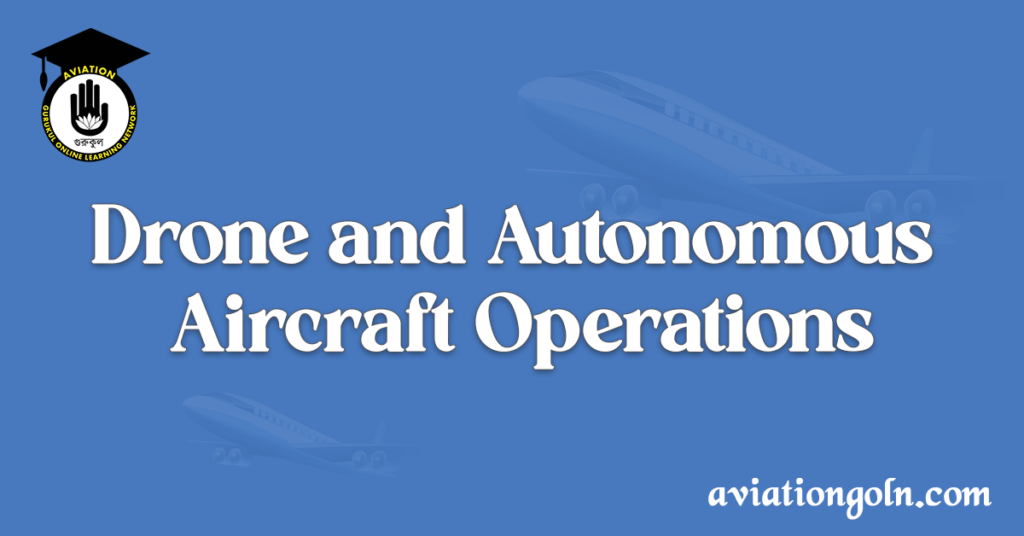Drone and Autonomous Aircraft Operations: The aviation industry is undergoing a significant revolution, with drone and autonomous aircraft operations being at the forefront. These innovative technologies have vast applications, from package deliveries to emergency response and beyond. This article will dive deep into the world of drones and autonomous aircraft, exploring their capabilities, advantages, potential challenges, and the future landscape of autonomous aviation.
Drone and Autonomous Aircraft Operations
1. Introduction to Drones and Autonomous Aircraft
At its simplest, a drone is an unmanned aerial vehicle (UAV). However, not all drones are truly autonomous; many require human operators to control them remotely. Autonomous aircraft, on the other hand, are capable of completing missions with minimal human intervention, relying on advanced onboard systems and algorithms.
2. Applications of Drones and Autonomous Aircraft
a) Delivery Services
Companies like Amazon and UPS are exploring drone deliveries for packages. They promise faster delivery times, especially in congested urban areas or remote locations.
b) Agriculture
Farmers use drones to monitor crop health, assess soil conditions, and even spray crops. They offer a bird’s-eye view of large plots of land, which can assist in spotting problem areas or diseases.
c) Surveillance and Security
Drones can be equipped with cameras and sensors to patrol sensitive areas, making them valuable for both private security and law enforcement operations.
d) Emergency Response
In search and rescue operations, drones can access hard-to-reach areas, provide real-time video feeds, and even deliver supplies to stranded individuals.
e) Entertainment and Media
Drone cinematography has introduced new dimensions to filmmaking, allowing for dynamic aerial shots that were previously impossible or too expensive.
3. Advantages of Drone and Autonomous Aircraft Operations
a) Cost-Effective
Operating manned aircraft can be expensive due to costs associated with pilots, crew, and larger infrastructure needs. Drones, especially in repetitive tasks, can be a cost-effective alternative.
b) Safety
Removing the human element can reduce the risk in dangerous missions, such as firefighting or inspections of high-voltage power lines.
c) Flexibility
Drones can be launched and operated in diverse environments where traditional aircraft might struggle.
d) Precision
For tasks like spraying crops, drones can be programmed to deliver exact amounts in specific locations, reducing waste and maximizing efficiency.
4. Challenges and Concerns
a) Air Traffic Management
As drones become more prevalent, there’s a need for a robust traffic management system to prevent aerial collisions.
b) Safety and Reliability
Ensuring drones and autonomous aircraft operate safely without malfunctioning is paramount, especially in densely populated areas.
c) Privacy Concerns
Drones equipped with cameras can pose privacy risks, leading to the need for clear regulations.
d) Regulatory Landscape
The FAA and other international aviation organizations are continuously working on regulations to ensure safe operations, but this is a rapidly evolving field, and keeping up can be challenging.
5. Technological Advancements
a) Machine Learning and AI
These technologies allow drones to recognize and respond to their environment, making their operations more dynamic and safe.
b) Advanced Sensors
Lidar, infrared, and high-resolution cameras are just a few of the sensors that enhance a drone’s capabilities.
c) Battery and Energy Storage
Improved battery life allows for longer missions and increased payload capacities.
6. Future of Drone and Autonomous Aircraft Operations
The future of drones and autonomous aircraft operations is limited only by imagination and technology. Some possible developments include:
- Urban Air Mobility (UAM): The rise of flying taxis and personal commuter drones could revolutionize urban transportation.
- Advanced Delivery Systems: Beyond packages, drones might deliver food, medicine, and other essentials directly to consumers.
- Environmental Monitoring: Autonomous aircraft can play a pivotal role in tracking climate change, monitoring wildlife, and assessing environmental threats.
Drone and autonomous aircraft operations hold the potential to reshape numerous industries, from agriculture to transportation. As the technology advances and regulations adapt, it’s only a matter of time before our skies are filled with a mix of manned and unmanned aircraft, working harmoniously to serve a multitude of purposes. The future of aviation is not just in the hands of pilots but also in the algorithms, sensors, and innovators who continue to push the boundaries of what’s possible.
Read more:

